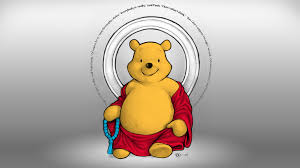The Tao of Pooh
Pooh bear holding onto a Tao kite
Winnie the Pooh has a certain way about him, a way of doing things which has made him the world’s most beloved bear. And Pooh’s Way, as Benjamin Hoff brilliantly demonstrates, seems strangely close to the ancient Chinese principles of Taoism. The ‘Tao of Pooh’ explains Taoism by Winnie the Pooh and explains Winnie the Pooh by Taoism. It makes you understand what A.A. Milne probably meant when he said he didn’t write the Pooh-books for children in the first place.
Over the centuries, Taoism classic teachings were developed and divided into philosophical, monastic, and folk religious forms. All of these could be included under the general heading of Taoism. But the basic Taoism is simply a particular way of appreciating, learning from, and working with whatever happens in everyday life. From the Taoist point of view, the natural result of this harmonious way of living is happiness.
One of the basic principles of Taoism is P’U; the Uncarved Block. The essence of the Uncarved Block is that things in their original simplicity contain their own natural power, power that is easily spoiled and lost when that simplicity is changed. This principle applies not only to things, but to people as well. Or Bears. Which brings us to Pooh, the very Epitome of the Uncarved Block. When you discard arrogance, complexity, and a few, other things that get in the way, sooner or later you will discover that simple, childlike, and mysterious secret known to those of the Uncarved Block: Life is Fun. Along with that comes the ability to do things spontaneously and have them work, odd as that may appear to others at times. As Piglet put it in ‘Winnie-the-Pooh’, “Pooh hasn’t much Brain, but he never comes to any harm. He does silly things and they turn out right.”
Owl sitting in his chair
Owl instead, is the opposite of Pooh, the Knowledge for the sake of Appearing Wise, the one who studies Knowledge for the sake of Knowledge, and who keeps what he learns to himself or to his own small group, rather than working for the enlightenment of others. That way, the scholars can appear Superior, and will not likely be suspected of Not Knowing Something. After all, from the scholarly point of view, it’s practically a crime not to know everything. But sometimes the knowledge of the scholar is a bit hard to understand because it doesn’t seem to match up with our own experience of things. Isn’t the knowledge that comes from experience more valuable than the knowledge that doesn’t?
While Owl’s little routine is that of Knowledge for the sake of Appearing Wise, Eeyore’s is that of Knowledge for the sake of Complaining About Something and Rabbit’s is that of Knowledge of Being Clever. As anyone who doesn’t have it can see, the Eeyore Attitude gets in the way of things like wisdom and happiness, and pretty much prevents any sort of real Accomplishment in life. Cleverness, after all, has its limitations. Its mechanical judgements and clever remarks tend to prove inaccurate with passing time, because it doesn’t look very deeply into things to begin with. The thing that makes someone truly different -unique, in fact- is something that Cleverness cannot really understand.
Pooh and Christopher Robin help Tigger
“A fish can’t whistle and neither can I.” There’s nothing wrong with not being able to whistle, especially if you’re a fish. But there can be lots of things wrong with blindly trying to do what you aren’t designed for. Unfortunately, some people aren’t so wise, and end up causing big trouble for themselves and others. The wise know their limitations; the foolish do not. To demonstrate what we mean, we can think of no one better than Tigger, who doesn’t know his limitations (‘Tiggers’ can do everything’), which brings him in lots of trouble. Piglet instead knows his limitations and that’s what makes him sometimes more brave than you would expect from such a small animal. So, the first thing we need to do is recognize and trust our own Inner Nature, and not lose sight of it. Inside the Bouncy Tigger is the Rescuer who knows the Way, and in each of us is something Special, and that we need to keep:
“Tigger is all right really,” said Piglet lazily.
“Of course he is,” said Christopher Robin.
“Everybody is really,” said Pooh. “That’s what I think,” said Pooh.
“But I don’t suppose I’m right,” he said.
“Of course you are,” said Christopher Robin.
This text is taken from ‘The Tao of Pooh’ by Benjamin Hoff, published by Mandarin Paperbacks. Also published by Mandarin Paperbacks and written by Benjamin Hoff; ‘The Te of Piglet’
Retrieved from:
http://www.just-pooh.com/tao.html
.

